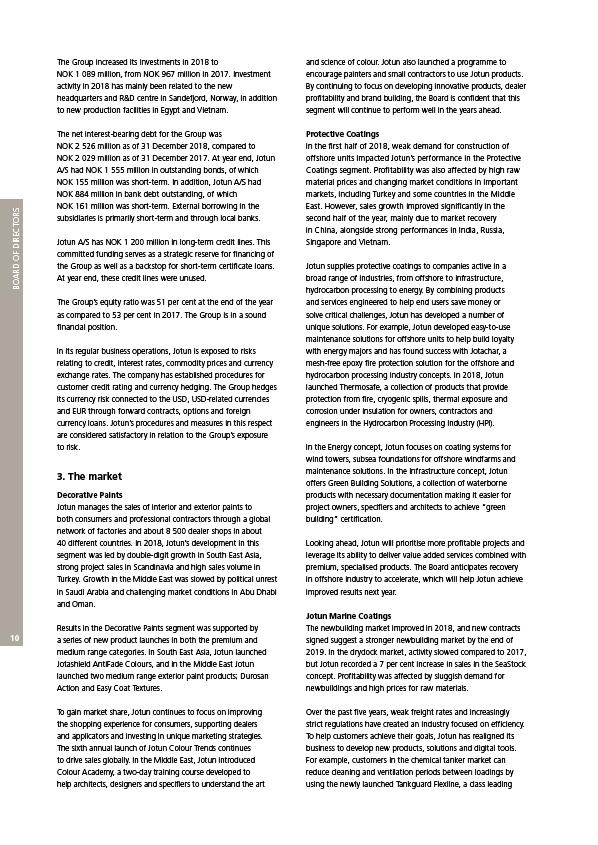
BOARD OF DIRECTORS
10
The Group increased its investments in 2018 to
NOK 1 089 million, from NOK 967 million in 2017. Investment
activity in 2018 has mainly been related to the new
headquarters and R&D centre in Sandefjord, Norway, in addition
to new production facilities in Egypt and Vietnam.
The net interest-bearing debt for the Group was
NOK 2 526 million as of 31 December 2018, compared to
NOK 2 029 million as of 31 December 2017. At year end, Jotun
A/S had NOK 1 555 million in outstanding bonds, of which
NOK 155 million was short-term. In addition, Jotun A/S had
NOK 884 million in bank debt outstanding, of which
NOK 161 million was short-term. External borrowing in the
subsidiaries is primarily short-term and through local banks.
Jotun A/S has NOK 1 200 million in long-term credit lines. This
committed funding serves as a strategic reserve for financing of
the Group as well as a backstop for short-term certificate loans.
At year end, these credit lines were unused.
The Group’s equity ratio was 51 per cent at the end of the year
as compared to 53 per cent in 2017. The Group is in a sound
financial position.
In its regular business operations, Jotun is exposed to risks
relating to credit, interest rates, commodity prices and currency
exchange rates. The company has established procedures for
customer credit rating and currency hedging. The Group hedges
its currency risk connected to the USD, USD-related currencies
and EUR through forward contracts, options and foreign
currency loans. Jotun’s procedures and measures in this respect
are considered satisfactory in relation to the Group’s exposure
to risk.
3. The market
Decorative Paints
Jotun manages the sales of interior and exterior paints to
both consumers and professional contractors through a global
network of factories and about 8 500 dealer shops in about
40 different countries. In 2018, Jotun’s development in this
segment was led by double-digit growth in South East Asia,
strong project sales in Scandinavia and high sales volume in
Turkey. Growth in the Middle East was slowed by political unrest
in Saudi Arabia and challenging market conditions in Abu Dhabi
and Oman.
Results in the Decorative Paints segment was supported by
a series of new product launches in both the premium and
medium range categories. In South East Asia, Jotun launched
Jotashield AntiFade Colours, and in the Middle East Jotun
launched two medium range exterior paint products; Durosan
Action and Easy Coat Textures.
To gain market share, Jotun continues to focus on improving
the shopping experience for consumers, supporting dealers
and applicators and investing in unique marketing strategies.
The sixth annual launch of Jotun Colour Trends continues
to drive sales globally. In the Middle East, Jotun introduced
Colour Academy, a two-day training course developed to
help architects, designers and specifiers to understand the art
and science of colour. Jotun also launched a programme to
encourage painters and small contractors to use Jotun products.
By continuing to focus on developing innovative products, dealer
profitability and brand building, the Board is confident that this
segment will continue to perform well in the years ahead.
Protective Coatings
In the first half of 2018, weak demand for construction of
offshore units impacted Jotun’s performance in the Protective
Coatings segment. Profitability was also affected by high raw
material prices and changing market conditions in important
markets, including Turkey and some countries in the Middle
East. However, sales growth improved significantly in the
second half of the year, mainly due to market recovery
in China, alongside strong performances in India, Russia,
Singapore and Vietnam.
Jotun supplies protective coatings to companies active in a
broad range of industries, from offshore to infrastructure,
hydrocarbon processing to energy. By combining products
and services engineered to help end users save money or
solve critical challenges, Jotun has developed a number of
unique solutions. For example, Jotun developed easy-to-use
maintenance solutions for offshore units to help build loyalty
with energy majors and has found success with Jotachar, a
mesh-free epoxy fire protection solution for the offshore and
hydrocarbon processing industry concepts. In 2018, Jotun
launched Thermosafe, a collection of products that provide
protection from fire, cryogenic spills, thermal exposure and
corrosion under insulation for owners, contractors and
engineers in the Hydrocarbon Processing Industry (HPI).
In the Energy concept, Jotun focuses on coating systems for
wind towers, subsea foundations for offshore windfarms and
maintenance solutions. In the Infrastructure concept, Jotun
offers Green Building Solutions, a collection of waterborne
products with necessary documentation making it easier for
project owners, specifiers and architects to achieve “green
building” certification.
Looking ahead, Jotun will prioritise more profitable projects and
leverage its ability to deliver value added services combined with
premium, specialised products. The Board anticipates recovery
in offshore industry to accelerate, which will help Jotun achieve
improved results next year.
Jotun Marine Coatings
The newbuilding market improved in 2018, and new contracts
signed suggest a stronger newbuilding market by the end of
2019. In the drydock market, activity slowed compared to 2017,
but Jotun recorded a 7 per cent increase in sales in the SeaStock
concept. Profitability was affected by sluggish demand for
newbuildings and high prices for raw materials.
Over the past five years, weak freight rates and increasingly
strict regulations have created an industry focused on efficiency.
To help customers achieve their goals, Jotun has realigned its
business to develop new products, solutions and digital tools.
For example, customers in the chemical tanker market can
reduce cleaning and ventilation periods between loadings by
using the newly launched Tankguard Flexline, a class leading